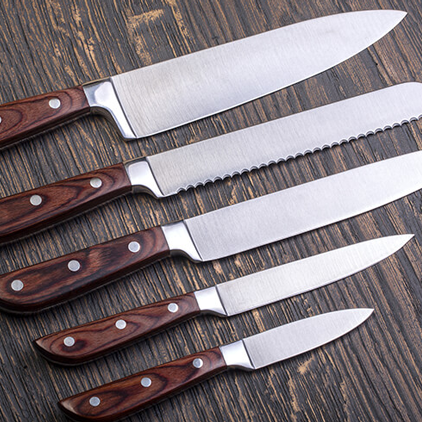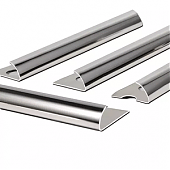carbon steel and stainless steel?

Do you know the difference between carbon steel and stainless steel?
High carbon steel is often used for high-end kitchen knives because it is wear-resistant, meaning it stays sharper longer.
Steel is found in products ranging from aerospace to kitchenware. Such diverse applications require a versatile material – and steel fits the bill.
"Steel" actually describes an entire family of metal alloys, with hundreds of application-specific grades, but most people divide steel into two broad categories: carbon steel and stainless steel.
Carbon steel and stainless steel have the same basic composition of iron and carbon. Their main difference is the alloy content - carbon steel has less than 10.5% alloy, while stainless steel must contain 10.5% or more chromium.
Steel composition.
The basic elements of steel are iron and carbon. Generally speaking, steels with higher carbon content are hard and brittle, while steels with lower carbon content are ductile and tough.
Alloying elements such as chromium, molybdenum, nickel, mangane se or silicon can be added to improve corrosion resistance or achieve a better balance between strength and toughness.
Carbon steel is composed of iron and 0.12 – 2.00% carbon. A broader definition includes alloy steels, which can also contain alloys as high as 10.5%. Even within the carbon content range of less than two percent, there are huge differences in physical properties, especially hardness.
When people talk about carbon steel, they are usually referring to the high-carbon steel used in knives and tools. High carbon steels are very hard, which makes them resistant to wear and shape very well. They can withstand large forces before deforming. Unfortunately, hard metals are also brittle: When placed under extreme tensile stress, high-carbon steel is more susceptible to cracking than bending.
Mild steel is more common than high carbon steel because
(1) it is less expensive to produce, (2) it is more ductile, and (3) it is easier to manufacture. Mild steel tends to deform under stress rather than break, and this ductility makes mild steel easy to machine and weld. They are frequently used in automotive body panels, bolts, clamps, seamless tubes and steel plates.
Stainless steel is used in chemical and food plants because of its ability to function in humid environments without rusting.
Stainless steel contains iron, carbon and a chromium content of at least 10.5%. Chromium is key - it reacts with oxygen to form a passivating layer that protects the steel from corrosion. This protection reduces the likelihood of stainless steel rusting – important for outdoor venue furniture (such as bollards) installed in humid environments. The higher the chromium content, the better the corrosion resistance.
When shopping for appliances and other big-ticket items, be sure to pay attention to the grade of stainless steel. Not all steel is created equal. Stainless steel with a minimum chromium content of 10.5% is much cheaper and less durable than stainless steel with a chromium content of 16%, and the difference will be reflected in maintenance costs and service life.
Carbon Steel Vs Stainless Steel Knives.
Home cooks often choose stainless steel knives. Professionals often choose high carbon steel.
Why? Stainless steel knives are more common and easier to store. Martensitic stainless steel is commonly used for cutting edges. These stainless steels are harder than other grades. However, they're not as brittle as harder high-carbon steel: they can be thrown into the dishwasher or knocked against marble.
For home cooks who don't do precision knife work, this is usually enough. In this case, rust prevention helps keep the blade sharp. Iron oxide on the cutting edge can dull the knife as it wears out.
Professional chefs usually prefer high carbon steel knives. These knives can be ground to a very sharp edge and are generally more wear-resistant than stainless steel. High carbon grades maintain finer edges even with regular use. Very hard metals are also brittle: when the impact force is too high, the metal does not bend, it breaks. This means that a high-carbon blade is less likely to deform upon impact, causing the edge to be lost through a series of warps. Instead, they maintain a nice, clean line, and when they break, they crumble.
Hard steel like this requires more care. Oil before storing to prevent rust, rinse after use in very salty or acidic conditions, and re-edge on stone .
Should I choose carbon steel or stainless steel?
Carbon steel and stainless steel are different, but not necessarily better than the other. It's all about context. Each material has advantages and disadvantages – the key is matching the steel to the job requirements.
High-carbon steel Advantage:
Easy to rust、crisp、Wear-resistant.
Stainless steel Advantage:
Resistant to rust、not so crispy、Poor wear resistance.
Related Products

Factory Introduction
Choose the right stainless steel material according to your needs
316N Stainless Steel
Contact Us